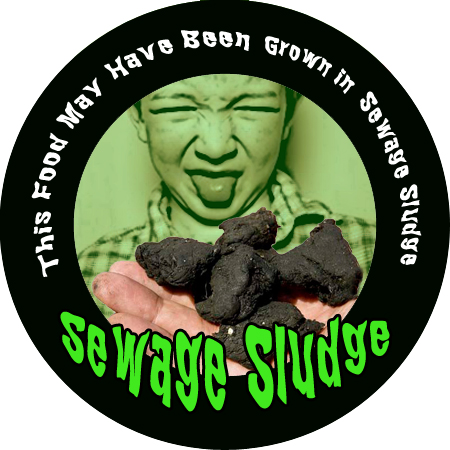"Don't Ask, Don't Tell": Concerned Citizen Uncovers Whole Foods' Policy on Selling Food Grown in Sewage Sludge
Don't fancy the thought of your spinach and carrots being grown in sewage sludge?
Neither does Mario Ciasulli, a semi-retired electrical engineer living in Chapel Hill, North Carolina. Mario likes to cook, and enjoys good food. When he found out last year about the practice of spreading dried and heated human and industrial waste as "fertilizer" on food crops, he was upset.
Certified organic food cannot be grown in sewage sludge -- or "biosolids," the Orwellian PR euphemism used by the sewage sludge industry.
But sometimes the vegetable Mario needs for a dish isn't certified organic, or he can't afford the higher price of the organically grown version. Until he found out about sludge, he thought that as long as a "conventionally" grown fruit or vegetable he used wasn't one of the "dirty dozen" for pesticide residues, he had nothing to worry about.
Sewage sludge is created by all of the human waste flushed down the toilet and sinks -- which includes all the pharmaceutical residues the men, women, and children in the city using the sewage system use -- and all the material corporations flush down the drain, which can include industrial materials, solvents, medical waste, and other chemicals. The water is removed from the sludge, and it is heated to kill certain bacteria, but the heating of the sewage sludge does not remove metals, flame retardants (which California recently listed as a carcinogen, or cancer-causing agent), and other chemicals that remain in the sewage sludge when food crops are grown in it.
 In addition to flame retardants and metals, sewage sludge has been shown to contain toxic substances and other contaminants such as endocrine disruptors, pharmaceutical residues, phthalates, industrial solvents, resistant pathogens, and perfluorinated compounds. Some of these contaminants can "bioaccumulate" in plants grown in sludge-contaminated soil and remain as residue on vegetables in contact with the soil. These plants are then eaten by children and adults.
In addition to flame retardants and metals, sewage sludge has been shown to contain toxic substances and other contaminants such as endocrine disruptors, pharmaceutical residues, phthalates, industrial solvents, resistant pathogens, and perfluorinated compounds. Some of these contaminants can "bioaccumulate" in plants grown in sludge-contaminated soil and remain as residue on vegetables in contact with the soil. These plants are then eaten by children and adults.
Because he thought that other food shoppers would be as nervous about eating food grown in sewage sludge as he was, Mario believed that information about which "conventional" produce is grown in sewage sludge should be publicly available. So he decided to ask around at local grocery stores, to see what their policy was on purchasing from producers who grow crops in sewage sludge, and notifying their shoppers of the risks.
Mario asked first at Whole Foods Market, because he believed its public statements about transparency and educating its shoppers.
Mario went back and forth for months with the "team members" and "team leader" at his local store in Chapel Hill. He even had an email conversation with the vice president of his southern region of Whole Foods stores.
Everyone told him that Whole Foods neither asks farmers whether or not they grow food in sewage sludge, nor will they tell consumers about the possible risks from sewage sludge when they buy "conventional" produce instead of certified organic fare.
 When Mario asked the regional vice president, "Why does WF allow non-organic produce on shelves without checking the conditions they're grown in?" he called the answer he got "corporate doublespeak" and summed it up as: "Whole Foods don't ask, [and] they [the farmers] don't tell."
When Mario asked the regional vice president, "Why does WF allow non-organic produce on shelves without checking the conditions they're grown in?" he called the answer he got "corporate doublespeak" and summed it up as: "Whole Foods don't ask, [and] they [the farmers] don't tell."
Mario has suggested that Whole Foods Market ask farmers who supply non-organic produce a simple question: "Do you spread 'biosolids' on any land where you grow crops sold to Whole Foods?"
Then, armed with this information, Mario has asked Whole Foods to label produce grown in sewage sludge. As signs in Whole Foods' meat departments say, "The more you know, the better."
Tell Whole Foods to end its "don't ask, don't tell" policy about food potentially grown in sewage sludge. Click here to ask Whole Foods Market DO ask and DO tell customers about sewage sludge. Watch CMD's Food Rights Network's interview with Mario on YouTube here and share it with your friends.





Comments
It's more than trace elements
Testing for trace elements ignores one of the worst problems which is pharmaceuticals.
Stop the treadmill
Shouldn't $h!† where we eat. Sewage sludge contains heavy metals and other waste products that are absorbed into crop foods through a process called phytoremediation (google it). Even "trace amounts" (if you want to call them that) of these toxins don't belong in our soils. They need to be processed and disposed of properly, not fed to the cycle to cause disease to sell more medicine. I'd love to find out how these entities are tied to big medicine.
Its a closed planetary cycle
Just so that its known, the earth is covered by a thin layer of animal waste. Its that thin layer of waste that makes it possible to grow plants, which in turn feed us animals so that we can - once again - feed the plants. Maybe its just me, but it seems to be a beautiful thing. Plants use solar energy and our waste products to produce food for us. We use that concentrated solar energy to move our bodies and return plant food to the cycle.
Whether you realize it or not, the earth is a closed system. All the raw materials we will ever use are already here, and most of them have been used before by our ancestors or other life forms. That water you are enjoying out of that plastic bottle was at one time or another the urine of someone or some thing. Failure to see this does not make it false.
Using sterilized human waste to grow food for humans keeps that waste out of the rivers and streams and causes it to shorten the cycle that MUST happen to keep us all alive.
Human waste is not the issue!!
If you will do your homework, you will find that the pharmaceuticals, chemicals and other toxins are of man made origins and not part of the network you described. You need to do some homework before you pollute with bad information.
Biosolid use on plants for human consumption
As someone who is currently creating a job analysis and selection procedures for soil scientists, I have been given great insight into biosolids, soil chemistry, microbiology, agronomy etc. to complete these tasks. The information I have gathered from the usage of biosolids on plants is not something that should be met with such backlash. Yes, there are trace elements in these pelletized biolsolids, but strict measures are taken to ensure that "if" the state even allows the use of biosolids on plants for direct human consumption, of which Illinois and various others ARE NOT allowed by regulations, these trace elements are kept under close scrutiny so as to not be able to have significant impacts on human health. The standards that this "sludge" goes through is a very sophisticated and arduous process that is able to delineate all but the trace amounts of such elements, of which some "could" be toxic in large quantities. As someone who tries to eat organic at all costs, I don't see this as being the huge problem you are making it out to be. As long as the regulations are in place to ensure these very trace elements, of which are already found in some types of soil depending on your location, then the usage of pelletized biosolids on should not pose any direct risk to one's health.
Standards for Biosolids
I imagine the previous post refers only to fertilizers commercially manufactured from sewage sludge and tested for metal residues. It's good to have standards for traces of heavy metals but I doubt that any of these standards can take into account the long term accumulation of these metals in the soil. Many are chemically reactive and bind to the soil so they don't "go away". Continuous additions of biosolids will just keep increasing their soil concentration.
But heavy metals are not the only dangerous components of biosolids coming from sewage. There are thousands of man-made organic compounds for which screening would be impossible. Research studies have found residues and metabolic products of pharmaceutical compounds that have passed through people using medications, including some radioactive tracers. We know some of these organic residues pose a health risk.
I live in a rural area where pumping out homeowners' septic tanks is a thriving business. When mine was pumped recently I saw the operator add a bag of lime to the sewage being pumped into his tank truck. When I asked him why he did that he said "That will turn it into fertilizer." I said "I thought you would pump this into the sewage plant in town." He said "Oh no. This will all get used as fertilizer." I would guess that this practice is widely spread across the country and represents a significant source of sewage-derived fertilizer to which no processing and no standards apply. And since it is not strictly a biosolid it probably doesn't get reported even in those states that regulate biosolids.
"trace elements...under close scrutiny...to delineate..."
Anonymous,
I am curious as to what the process of "scrutiny" and "delineat[ion]" is, and the "strict measures...taken" that will ensure that the consumer consumes no more than "trace amounts of such elements," which you say could only be toxic in "large quantities."
My understanding is that some of these toxins are cumulative. So the concept of "trace" evolves into "concentration" at some point in time. My understanding of the word delineate means to sketch, draw, outline or depict. I'm not aware of that word meaning "remove." Merely identifying is not "removing."
So, let's focus on removal, and what is known about it. There is a significant percentage of the public taking estrogenic compounds and other fertility and hormonal substances that are endocrine disrupting (EDC's), and are the most difficult to remove. There are in addition, large quanties of pain killers, anti-bacterial soap, etc. Those who study this (I worked with a water utility that did this research and explored treatment options for drinking water) know that there are as yet no agreed upon testing strategies and decision-making criteria for environmental monitoring and for sludge and water treatment. Most treatment plants do not yet have the more advanced methods, such as ozonation and activated carbon treatment, high enough temperature and nitification needed to remove the EDC's.
Your reply to this blog strikes me as more of the "double speak" and vagary described as being used on him when he complained to Whole Foods. It is inaccurate to imply--as you have-- that these chemicals, now ubiquitious in the environment, can be removed to the degree that they are at a "trace" / unharmful level, and it is inaccurate to imply that there is scientific agreement even on what "trace" means in the context of the wide range of humans and animals, from pregnant mothers to infants to elderly with serious medical conditions.
"Biosolids"
You make some interesting points. Unfortunately, since you chose to identify yourself as "Anonymous", there is no way I can accept your statements as valid. You statement "As someone who is currently creating a job analysis and selection procedures for soil scientists . . . " causes me to question exactly how "unbiased" you are. Who is funding your work? There needs to be some transparency before I am convinced you are not employed by the exact people who foist this on an unsuspecting public.
Just wondering...
Would it compromise your anonymity too much to tell us specifically what organization, agency or company is employing you to create this job analysis and selection procedure?
Where should I submit my resume if I were interested in applying?
Agree
Yes, I agree, but my background extends in a slightly different direction. Human waste has been used for thousands of years to fertilize fields. I remember around twenty years ago a college professor friend who went to China to study cultural and political topics. He wrote about "honey buckets." You can assess what these were about from the expression, but these were buckets in which people deposited their urin and feces. The buckets were taken to the fields and dumped. The contents of the buckets were prized, and it was, in the context in which the professor was working, a compliment to deposit in somone's honey bucket.
Granted, China has changed, and industry and scale make a difference, but I agree that negatively reacting to use of human manure for fertilizer is probably not merited. If there is a problem, it is not the fertilizer itself so much as the materials that accumulate in our sewer systems, mercury and lead being two of them. But EPA and other people who have knowledge of environmental engineering can deal with such things, and in the end, we might make better use of a fairly constant element of human life. With over seven billion of us, it would be cool if we could figure out some better approaches to closing ecological cycles. Industrial phosphates are fine, but so is natural fertilizer.